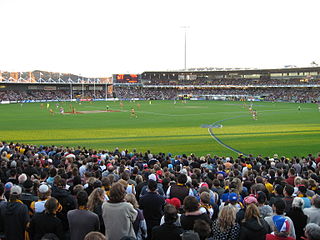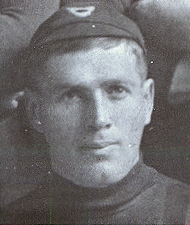Related Research Articles

The Tasmanian State League (TSL), colloquially known as the Tasmanian Football League (TFL), was the highest-level Australian rules football competition in the state of Tasmania. It disbanded following the end of the 2024 season in preparation for the Tasmania Football Club to enter the Victorian Football League (VFL) in 2026.

North Hobart Oval is a sports venue in North Hobart, Tasmania. Formerly used primarily for Australian rules football widely regarded as the traditional home of Australian football in Tasmania. However since the 1950s it has also become one of the main soccer, rugby league and rugby union venues in Tasmania.

In Tasmania, Australian rules football is a popular spectator and participation sport. It has been played since the late 1860s and draws the largest audience for any football code in the state. A 2018 study of internet traffic showed that 79% of Tasmanians are interested in the sport, the highest rate in the country. It is governed by AFL Tasmania and according to Ausplay there are 13,927 adult players with a participation rate of 2.5% per capita about a quarter of which are female playing across 12 competitions.

The New Norfolk District Football Club, nicknamed The Eagles, is an Australian rules football club currently playing in the Southern Football League, in Tasmania, Australia.

The North Hobart Football Club, nicknamed The Demons, is an Australian rules football club which plays in the Tasmanian State League. The club returned to the state league in 2018 after its position was effectively filled by a new club, the Hobart City Football Club after the 2013 season. The club was part of the Tasmanian Football League from the early 1900s through to 2001, where the club joined Southern Football League. In 2009, the club was invited into the second reincarnation of the statewide league where it remained until 2013.
John Herbert Devine was an Australian rules footballer who played with Geelong in the Victorian Football League (VFL) during the 1960s, and Tasmanian Football League (TFL) side North Hobart between 1967 and 1974.
Cananore Football Club was an Australian rules football club founded in 1901. It competed in the Tasmanian Football League (TFL/TANFL) as a junior club from 1901 to 1907, and as a senior club between 1908 and 1941. They were known as the Canaries and wore black and gold as their club colours.
Terence Robert Cashion was an Australian rules footballer from Tasmania who played numerous representative matches for the state and also played for South Melbourne in the Victorian Football League (VFL).

West Park Oval is an Australian Rules football, cycling and athletics venue located on the shores of Bass Strait in Burnie, Tasmania. It is the current home of the Burnie Dockers in the Tasmanian State League and previously in the NTFL and in the original TFL Statewide League.

Harold Kennedy "Joe" Littler was an Australian rules footballer who played for South Melbourne in the Victorian Football League (VFL). He also had a long career in Tasmania playing in the Northern Tasmanian Football Association, North West Football Union (NWFU), and the North West Football Association (NWFA).
The North West Football Union (NWFU) was an Australian rules football competition which ran from 1910 to 1986 on the north western coast of Tasmania. In its time it was one of the three main leagues in Tasmania, with the Tasmanian Football League in Hobart and Northern Tasmanian Football Association in Launceston representing the rest of the state. Burnie, Latrobe and Ulverstone were the most successful clubs with 12 premierships each.
The Winfield Statewide Cup was an Australian rules football tournament held in Tasmania, Australia between the top twenty-one (21) major football clubs across Tasmania from the three major footballing bodies across the state, the TANFL, the NTFA and the NWFU.
The 1945 Tasmanian Australian National Football League (TANFL) premiership season was an Australian Rules football competition staged in Hobart, Tasmania over fifteen (15) roster rounds and four (4) finals series matches between 5 May and 29 September 1945.
Statewide Australian rules football competition has been played in Tasmania, Australia under the umbrella of the Tasmanian Football League from 1986–1998, Football Tasmania from 1999–2000 until the competition was disbanded in December 2000 and AFL Tasmania from 2009 when a new ten-club competition, this time known as the Tasmanian State League, was formed.
The 1967 Tasmanian State Premiership Final was an Australian rules football match played between the Wynyard Cats and the North Hobart Robins on Saturday 30 September 1967 at West Park Oval, Burnie, to decide the winner of the 1967 Tasmanian State Premiership. One of the most controversial games in Australian rules football history, the match was declared no result and the premiership was withheld after fans invaded the field and eventually took down the goal posts, preventing North Hobart full-forward David Collins from taking a kick after the siren which would likely have won or tied the game for the Robins.
The 1941 Tasmanian Australian National Football League (TANFL) premiership season was an Australian rules football competition staged in Hobart, Tasmania, over fourteen roster rounds and two finals series matches between 10 May and 20 September 1941.
Noel William Atkins was a former Australian rules footballer, who played for various senior clubs in Tasmania between 1945 and 1959. He also represented the state several times in interstate matches, and was inducted into the Tasmanian Football Hall of Fame in 2005.
The 1940 TANFL season was the 59th season of the Tasmanian Australian National Football League (TANFL), the highest-level senior Australian rules football competition in southern Tasmania.
References
- ↑ "State Premiership Trophy Offered". The Daily Telegraph. Launceston, TAS. 4 October 1915. p. 3.
- ↑ "Football: North Hobart Club". The Mercury. Hobart, TAS. 23 March 1921. p. 8.
- ↑ "North Launceston earns right to meet Hobart". The Mercury. Hobart, TAS. 9 October 1950. p. 12.
- ↑ Forward (29 January 1951). "State Football title out this season". The Mercury. Hobart, TAS. p. 7.
- ↑ "State title football to be official". Examiner. Launceston, TAS. 1 March 1954. p. 12.
- ↑ "Football: the club premiership". The Mercury. Hobart, TAS. 8 September 1913. p. 7.
- ↑ "Football friction in Tasmania". Referee. Sydney, NSW. 1 October 1913. p. 13.
- ↑ "Athletic Chaos in Tasmania". Sunday Times. Sydney, NSW. 28 December 1913. p. 32.
- ↑ "The disqualification trouble". Daily Post. Hobart, TAS. 25 December 1913. p. 7.
- ↑ "The Football Trouble". Examiner. Launceston, TAS. 5 June 1914. p. 7.
- ↑ "The football dispute". Daily Post. Hobart, TAS. 17 June 1914. p. 8.
- Results and attendances courtesy of the Hobart Mercury, Launceston Examiner and The North West Advocate publications.
- Full Points Footy: Tasmanian State Premiership Matches [usurped]